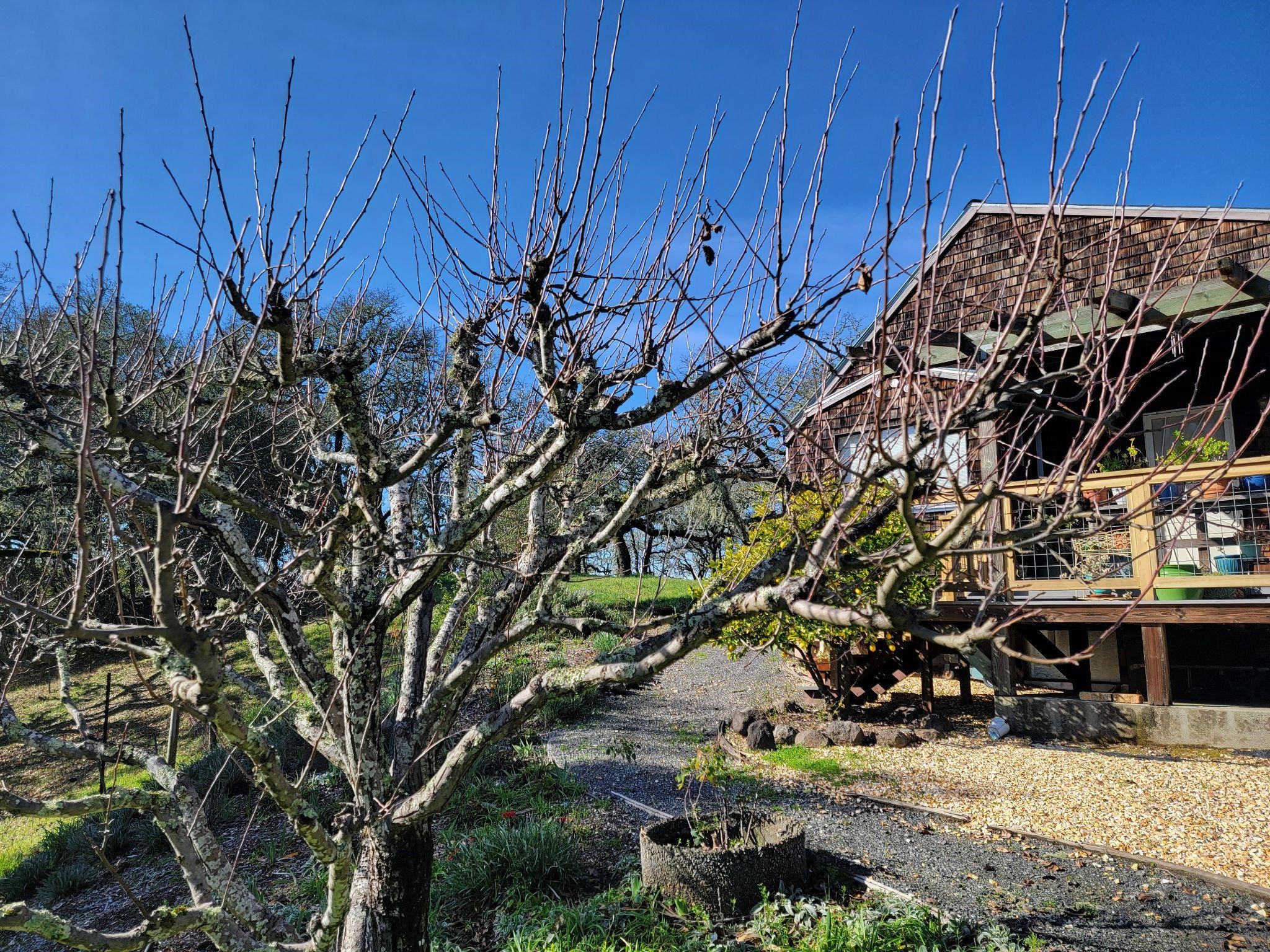
Winter Pruning and Care for Fruit Trees in Sonoma County
As Healdsburg landscapers, we manage a number of orchards for both private and commercial use. Many property owners in Healdsburg and greater Sonoma County take advantage of our incredible growing climate to produce fruit for their family, friends, businesses and restaurants. However, when it comes time to make the cuts many folks find themselves unsure of exactly how to go about it, here are some key tips to ensure you have a bountiful and flavorful harvest and trees that will last many years to come!
Timing of Pruning is Key
Fruit trees are best pruned right after the leaves have finished dropping because this is the start of the dormant period which can be short lived in Healdsburg landscapes as warm weather often sneaks up on us. The first reason that pruning during the dormant season is important is that the tree is no longer exchanging nutrients between its roots and foliage which limits the amount of stress caused to the tree through pruning. Second is that it allows us to better visualize the entire structure of the trees. Third is that the cuts we make will determine where, and how much new growth the tree produces in the growing season. Lastly is that it allows us access to apply organic fungicides and insecticides to combat pests during a season when insects and pollinators aren’t active and therefore having a minimal impact on the ecosystem. Contacting Sonoma County landscaping companies such as Inspired landscapes for guidance on pruning will take away the guesswork maintaining your orchard!

How and Where to Make Cuts
Our goal with pruning is to promote the type of growth that will produce healthy fruit. This means allowing light and airflow to reach the fruiting sites on the tree. Most fruit trees will produce fruit on second year growth, meaning the new long branches that will emerge in the spring will only produce more leaves and not the fruit we are seeking. For this reason we want to reduce the amount of buds in the upper canopy by removing much of the long fresh branches from last year’s growth. However we want to be sure to leave a small number of budding sites on this wood so that the tree will produce fruit, too hard of a prune and you wont get any fruit at all, so prune with intention!
Next we want to remove any branches which are crossing and rubbing against each other. This rubbing will damage the bark and lead to disease and rot over time which could end up requiring removal of major branches and even the death of the tree. Additionally we want to thin the canopy of the tree to allow light to reach the fruiting locations, and increase airflow, both of which will improve fruit production and reduce pests from taking hold. Lastly it’s helpful to control the overall height of your tree when pruning so that fruit is within reach when it is produced. Fruit that requires a ladder to pick is often left to fall on the ground, so make it easy for yourself and keep the tree down to 6-7 ft in height.
Inspired Landscapes provides expert landscaping services in Sonoma County meaning our crews are knowledgeable and well equipped with the correct tools that are properly sharpened. A dull blade will lead to a sloppy cut which can take quite a bit of energy to heal, and reduces what energy the tree has for fruit production. Small branches can be pruned with hand shears, where larger branches require loppers or a saw. Make cuts about ½’’-1’’ away from a bud to allow for the branch without damaging the nearby buds. Prune above a bud that faces the direction you want the new branches to grow, ideally that means ‘up and out’ from the trunk of the tree.
Fertilization and Pest Control
As a company that focuses on sustainable landscaping practices, we emphasize using the most effective and low impact methods of fertilization and pest control. While it’s common practice to purchase granulated or liquid fertilizers, these products don’t take into account a holistic approach to plant health. While plants, and fruit trees in particular, need specific minerals to produce healthy foliage and fruit, often those minerals are unavailable to the plant because the soil itself is unhealthy. By applying compost after pruning in a 2-4’’ layer around the base of the tree, we are not only feeding it the minerals it needs to grow, but adding microorganisms which build a healthy soil food web which increases bioavailability of these minerals to the plants. Without a healthy soil food web and balanced pH, the trees can’t use the nutrients that are in the soil. In our experience as Sonoma County landscape contractors, applying compost creates far better results year over year with trees that are drought and pest resistant and produce heavy flavorful crops.
Pest control is best done after pruning in the winter months when most insects and pollinators lay dormant. Additionally, many of the pests over winter on the branches and in the soil or leaves below the tree. For this reason the first step is to remove last year’s leaves from below the tree, this will help reduce fungal diseases on the leaves which could be transferred into the soil, and insect populations which have laid eggs in this leaf litter. The next step is to apply an organic horticultural oil to all surfaces of the branches and trunk of the tree, this mineral oil smothers eggs of pest insects that are hoping to overwinter on your tree. Lastly organic sprays to contain fungal diseases such as peach leaf curl are important to apply during winter months as this disease most actively spreads during rain events which wash the fungus into the buds.
If you have the space in your garden, tending fruit trees is an immensely rewarding experience. There’s nothing quite like bringing in fresh fruit from the garden to share with your family, friends, and guests at the property. After all the horticultural care is complete you’ll want to be sure your irrigation system is adequate and properly programmed for each varieties specific needs, contact Inspired Landscapes, we are landscape irrigation specialists in Sonoma County who can handle all your irrigation and landscape tasks in the orchard and beyond!





